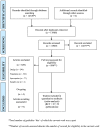Efficacy and safety of pharmacological and psychological interventions for the treatment of psychosis and schizophrenia in children, adolescents and young adults: a systematic review and meta-analysis
- PMID: 25671707
- PMCID: PMC4324833
- DOI: 10.1371/journal.pone.0117166
Efficacy and safety of pharmacological and psychological interventions for the treatment of psychosis and schizophrenia in children, adolescents and young adults: a systematic review and meta-analysis
Abstract
Background: Studies report contrasting results regarding the efficacy and safety of pharmacological, psychological, and combined interventions in psychosis and schizophrenia in children, adolescents and young adults.
Methods: Systematic review and meta-analysis. Embase, Medline, PreMedline, PsycINFO, and CENTRAL were searched to July 2013 without restriction to publication status. Randomised trials comparing any pharmacological, psychological, or combined intervention for psychosis and schizophrenia in children, adolescents and young adults were included. Studies were assessed for bias, and GRADE criteria were used to describe the quality of the results.
Results: Twenty-seven trials including 3067 participants were identified. Meta-analyses were performed for 12 comparisons: symptoms, relapse, global state, psychosocial functioning, depression, weight and discontinuation. Low quality evidence demonstrated that antipsychotics have small beneficial effects on psychotic symptoms (SMD = -0.42, 95% CI -0.58 to -0.26), and a medium adverse effect on weight gain (WMD = 1.61, 95% CI 0.61 to 2.60) and discontinuation due to side effects (RR = 2.44, 95% CI, 1.12 to 5.31). There were no trials of psychological treatments in under-18 year olds. There was no evidence of an effect of psychological interventions on psychotic symptoms in an acute episode, or relapse rate, but low quality evidence of a large effect for family plus individual CBT on the number of days to relapse (WMD = 32.25, 95% CI -36.52 to -27.98).
Conclusions: For children, adolescents and young adults, the balance of risk and benefit of antipsychotics appears less favourable than in adults. Research is needed to establish the potential for psychological treatments, alone and in combination with antipsychotics, in this population.
Conflict of interest statement
Figures
References
-
- Gillberg C (1984) Infantile autism and other childhood psychoses in a Swedish urban region. Epidemiological aspects. J Child Psychol Psychiatry 25: 35–43. - PubMed
-
- Burd L, Kerbeshian J (1987) A North Dakota prevalence study of schizophrenia presenting in childhood. J Am Acad Child Adolesc Psychiatry 26: 347–350. - PubMed
-
- Hellgren L, Gilberg C, Enerskog I (1987) Antecedents of adolescent psychoses: a population based study of school health problems in children who develop psychosis in adolescence. J Am Acad Child Adolesc Psychiatry 26: 351–355. - PubMed
-
- Gillberg C (2001) Epidemiology of early onset schizophrenia. Cambridge: Cambridge University Press.
Publication types
MeSH terms
Substances
Grants and funding
LinkOut - more resources
Full Text Sources
Other Literature Sources
Medical





